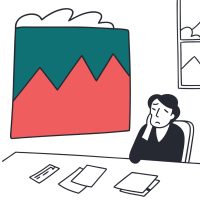Question More, Action Knowledge.
Remember, at QMAK, we don’t just teach; we empower. We don’t just inform; we inspire. We don’t just question; we act. Become a Gold Member, and let’s unlock your child’s full potential, one question at a time.
![]() Imagine you’re given a choice: either keep $100 that’s already yours, or flip a coin for the chance to win $200.
Imagine you’re given a choice: either keep $100 that’s already yours, or flip a coin for the chance to win $200.
Heads, you double your money; tails, you lose everything.
Which would you choose?
This scenario illustrates a powerful psychological principle that significantly influences human decision-making, particularly in business and financial contexts: loss aversion.
Loss aversion is the idea that losses loom larger than gains when we’re making decisions.
In other words, we tend to feel the pain of losing something much more intensely than the pleasure of gaining something of equal value.
According to renowned psychologist Daniel Kahneman, the loss aversion coefficient is about 1:2.5.
This means that for most people, the distress of losing $100 is about 2.5 times stronger than the joy of gaining $100.
We’d need the potential gain to be around $250 to make the gamble feel worth it.
This bias towards avoiding losses has deep evolutionary roots. For our ancestors, threats like starvation or predation were much more pressing concerns than missed opportunities. An organism that prioritized avoiding danger over seeking rewards was more likely to survive long enough to reproduce.
Loss aversion stems from our primal instincts to protect ourselves from threats and ensure survival. In the past, losses often carried severe consequences, potentially leading to starvation, injury, or even death. This innate fear of loss has been ingrained in our psychological makeup.
In the modern world, we don’t usually face such dire consequences. But our brains are still wired to feel losses more keenly than gains, which can lead to some interesting quirks in our decision-making.
Loss aversion can influence our choices in all sorts of ways, from the personal to the political.
For example:
![]() 1. Investing: Many people are reluctant to invest in the stock market because they overweight the potential for short-term losses, even though the long-term gains are likely to be much larger. This aversion to financial loss can lead to overly conservative investment strategies, potentially hindering growth opportunities.
1. Investing: Many people are reluctant to invest in the stock market because they overweight the potential for short-term losses, even though the long-term gains are likely to be much larger. This aversion to financial loss can lead to overly conservative investment strategies, potentially hindering growth opportunities.
![]() 2. Business Ventures: Loss aversion plays a significant role in deterring individuals from pursuing entrepreneurial ventures. The fear of losing a steady job and income often outweighs the potential benefits of starting a business, even if the opportunity holds significant promise.
2. Business Ventures: Loss aversion plays a significant role in deterring individuals from pursuing entrepreneurial ventures. The fear of losing a steady job and income often outweighs the potential benefits of starting a business, even if the opportunity holds significant promise.
![]() 3. Health: The fear of losing one’s health can be a more powerful motivator for lifestyle changes than the potential gains of better health in the future.
3. Health: The fear of losing one’s health can be a more powerful motivator for lifestyle changes than the potential gains of better health in the future.
![]() 4. Relationships: People often stay in unsatisfying relationships because the thought of losing the companionship feels worse than the lack of joy in staying.
4. Relationships: People often stay in unsatisfying relationships because the thought of losing the companionship feels worse than the lack of joy in staying.
![]() 5. Politics: Campaigns that focus on the potential losses if the other side wins (e.g., “they’ll take away your healthcare!”) can be more effective than those that emphasize the potential gains of their own policies.
5. Politics: Campaigns that focus on the potential losses if the other side wins (e.g., “they’ll take away your healthcare!”) can be more effective than those that emphasize the potential gains of their own policies.
![]() 6. Customer Behavior: Businesses can leverage loss aversion to influence customer behaviour. For instance, framing a purchase decision in terms of potential losses (e.g., “Don’t miss out on this limited-time offer”) can create a sense of urgency and encourage customers to act quickly.
6. Customer Behavior: Businesses can leverage loss aversion to influence customer behaviour. For instance, framing a purchase decision in terms of potential losses (e.g., “Don’t miss out on this limited-time offer”) can create a sense of urgency and encourage customers to act quickly.
Basically, anywhere there’s a decision to be made with potential risks and rewards, loss aversion is likely to be a factor.
Let’s look at some concrete examples that illustrate how loss aversion influences decision-making in different contexts:
In one instance, a brokerage mistakenly deposited an extra $10,000 into a bank account. Despite the money not rightfully belonging to the account holder, the prospect of returning it triggered a feeling of loss, even though it was simply a correction of an error.
This demonstrates the emotional discomfort associated with parting with something perceived as a gain, even if it was never truly possessed.

Many individuals aspire to own their own business but are deterred by the potential risks involved.
The possibility of losing a stable job and income often outweighs the potential rewards of entrepreneurship, highlighting how the threat of loss looms larger than the allure of potential gains.

Businesses use marketing tactics that tap into loss aversion to drive sales.
Limited-time offers, price increases with deadlines, and messaging that emphasizes what customers stand to lose by delaying a purchase create a sense of urgency, motivating them to act quickly to avoid a perceived loss.

: Loss aversion becomes particularly pronounced during economic recessions or depressions.
Experiencing job loss, a decline in home value, or a shrinking retirement fund triggers intense feelings of loss, leading individuals to adopt more conservative financial behaviors to avoid further losses.
This risk aversion can hinder economic recovery, as individuals shy away from investments or entrepreneurial activities that could potentially improve their situation.

While loss aversion is a deeply ingrained bias, there are ways to mitigate its effects on our decision-making.
Some strategies include:

Instead of focusing on what you might lose by making a change, try to shift your perspective to what you stand to gain. For example, instead of thinking about the time you’ll “lose” by exercising, focus on the health and energy you’ll gain.

Businesses can alleviate customer concerns about potential losses by offering generous return policies and money-back guarantees. By transferring the risk of a purchase to the seller, customers feel more secure and are more likely to proceed with the transaction.

The fear of loss can be paralyzing when we’re faced with a big, high-stakes choice. Breaking it down into a series of smaller, less risky decisions can make it feel more manageable.

Relying on objective data and analysis can help to counteract the emotional influence of loss aversion. By carefully evaluating potential costs and benefits, individuals can make more rational and informed decisions.

Remember that not making a decision is still a decision. By avoiding a potential loss, you may be missing out on an even bigger gain.

Our own loss aversion can blind us to possibilities that others might see more clearly. Talking through decisions with trusted friends or advisors can help broaden our view.

Developing a mindset of resilience and accepting that setbacks are an inevitable part of life can reduce the emotional sting of losses. By focusing on learning from mistakes and adapting to change, individuals can navigate challenges more effectively.

Regularly reflecting on what we’re grateful for can help counterbalance the tendency to fixate on potential losses.
Helping kids understand the concept of loss aversion can set them up to be savvier decision-makers throughout their lives.
Some ways to introduce the idea include:
1. Using relatable examples: Talk about how losing a favorite toy might feel much worse in the moment than the joy of getting a new one, or how missing out on a fun event to do homework can sting more than the satisfaction of getting a good grade.
2. Playing games with risk and reward: Set up simple games or bets where there are clear potential gains and losses, and talk about how the different outcomes feel. What would change their choices?
3. Discussing real-world examples: Point out cases of loss aversion in the news or in your own life, and talk through how the bias might be affecting people’s behavior.
4. Encouraging long-term thinking: Help kids see beyond the momentary pain of a loss to the bigger picture. What might they gain in the long run by taking a risk or making a tough choice?
5. Modeling healthy risk-taking: Share your own decision-making processes and show that sometimes, the potential gains are worth the risk of a loss.
Teacher’s Note: By building an awareness of loss aversion from an early age, we can equip the next generation to make more balanced, rational choices in a world full of risks and rewards.
While loss aversion can sometimes lead us astray, it can also be a powerful tool for positive change.
Some ways to use it to your advantage include:
Ultimately, loss aversion is a deeply rooted part of the human psyche that affects us all. By understanding its power and learning to work with it rather than against it, we can make smarter choices, achieve our goals, and grow in ways we never thought possible.
So the next time you’re facing a tough decision, don’t just ask yourself what you stand to gain. Ask what you might lose if you don’t act – and let that be the spark that ignites your motivation and propels you forward.
Objective: To introduce the concept of loss aversion through simple, relatable choices.
a. Present the class with a series of “Would You Rather?” questions that pit a potential gain against a potential loss. For example, “Would you rather get an extra cookie after dinner or avoid losing TV time for a night?”
b. Have students vote on their choices and discuss why they made the decisions they did.
c. Introduce the concept of loss aversion and explain how the fear of losing something can often outweigh the pleasure of gaining something else.
d. Repeat with more examples, discussing how loss aversion can influence our choices.
Objective: To explore how loss aversion affects decision-making in the face of risk and reward.
Objective: To identify examples of loss aversion in real-world contexts.
Objective: To practice reframing situations to focus on potential gains rather than losses.
Objective: To learn how to use loss aversion as a motivational tool for achieving goals.
The Aviator offers a compelling examination of loss aversion through Howard Hughes’ tumultuous journey as an aviation pioneer and business titan.
Through Hughes’ increasingly obsessive behavior, students witness how the fear of losing wealth, reputation, and control can drive seemingly irrational decisions.
As Hughes pours endless resources into projects like the massive Spruce Goose aircraft, refusing to abandon them despite mounting costs and technical challenges, viewers see how loss aversion can trap us in cycles of escalating commitment.
The film’s portrayal of Hughes’ deteriorating mental state – his growing paranoia and obsessive behaviors – demonstrates how the fear of loss can extend beyond financial decisions to consume every aspect of life.
Through this complex character study, students learn how loss aversion can transform from a natural protective instinct into a destructive force that paradoxically leads to the very losses we fear most.
(Verse 1)
There’s a force that guides our choices
A bias deep within
It’s the fear of losing something
That makes us think again
We feel the pain of losses
More than gains, it’s true
Loss aversion is the name
And it affects me and you
(Chorus)
Loss aversion, it’s a powerful thing
Makes us hold on tight to what we have
Loss aversion, it’s a part of our brain
Evolved to keep us safe from harm
(Verse 2)
It shows up in our investments
Our health and relationships
In politics and decision-making
Loss aversion’s in the mix
But we can overcome its power
With strategies and tools
Reframing losses into gains
And breaking big choices into smaller moves
(Bridge)
Opportunity costs, outside views
Gratitude to balance out the fear
Teach the kids, with examples clear
To make them savvy decision-makers year by year
(Chorus)
Loss aversion, it’s a powerful thing
Makes us hold on tight to what we have
Loss aversion, it’s a part of our brain
Evolved to keep us safe from harm
(Verse 3)
We can harness loss aversion
For personal growth and change
Frame healthy habits as preventing loss
And set up systems to hold us accountable
Visualize the cost of staying still
And prioritize preventing loss in deals
Reframe setbacks as lessons learned
And let them fuel our journey’s wheels
(Outro)
So when you’re faced with a choice that’s tough
Don’t just think of what you’ll gain
Consider what you might lose if you don’t act
And let that be your motivation’s flame
Loss aversion, it’s a part of who we are
But with awareness and skill, we can go far!
Remember, at QMAK, we don’t just teach; we empower. We don’t just inform; we inspire. We don’t just question; we act. Become a Gold Member, and let’s unlock your child’s full potential, one question at a time.